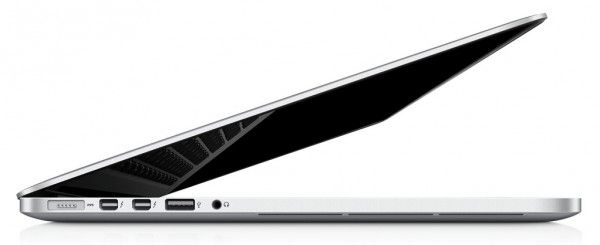 Today at Apple’s annual World Wide Developers Conference (WWDC) the company refreshed it’s lineup of laptop computers. The company also introduced a brand new addition to the lineup which will surely set the performance and feature bar for future Ultrabooks. Apple annoyingly is calling this the ‘Macbook Pro with retina display’, despite that it is smaller, lighter, and uses a totally different chassis than the Macbook Pro (it’s almost as thin as the MacBook Air, actually). The screen is 15.4″ and a whopping 2880×1800 resolution, but the unit is still fairly light at 2.02kg and thin at 18mm. Step inside to learn everything there is to know about Apple’s new MacBook Pro with retina display.
Today at Apple’s annual World Wide Developers Conference (WWDC) the company refreshed it’s lineup of laptop computers. The company also introduced a brand new addition to the lineup which will surely set the performance and feature bar for future Ultrabooks. Apple annoyingly is calling this the ‘Macbook Pro with retina display’, despite that it is smaller, lighter, and uses a totally different chassis than the Macbook Pro (it’s almost as thin as the MacBook Air, actually). The screen is 15.4″ and a whopping 2880×1800 resolution, but the unit is still fairly light at 2.02kg and thin at 18mm. Step inside to learn everything there is to know about Apple’s new MacBook Pro with retina display.
Don’t let the thinness and light weight fool you, there’s a lot of premium features in this beast. In fact, the Macbook Pro with retina display is even more powerful and feature rich than the thicker MacBook Pro lineup.
Retina Display, 2880×1800
The big news of course is the 15.4″ 2880×1800 display which is the highest resolution seen in an laptop computer and has 2.5x more pixels than the 1080p display found on Asus’ Zenbook Prime. Apple says that they’ve enhanced the contrast ratio, viewing angle, and have reduced the glare from the screen by 75% while maintaining the deep blacks that come from using a glossy display. Note that 2880×1800 is actually a 16:10 aspect ratio; in recent years most companies have been moving to 16:9, the same shape found on an HDTV, this is a step counter to that trend.
Processors
Based on Ivy Bridge, this is actually not using the same Ivy Bridge platform as specified by Intel’s Ultrabook criteria. To be an Ultrabook, a device must use the ULV (ultra low voltage) version of Intel’s processors (designated by a ‘U’ at the end of the CPU name. Instead, Apple has equipped the MacBook Pro with retina display with the mid-range option (designated with an ‘M’) which is hotter and more power hungry, but it also opens the door to quad-core options (designated with a ‘Q’) which is what this unit is equipped with.
Apple is offering two versions of the MacBook Pro with retina display. The low end configuration uses a ‘2.3GHz quad-core Intel Core i7 processor (Turbo Boost up to 3.3GHz) with 6MB shared L3 cache’ according to Apple, which we’re willing to bet maps to the i7-3615QM (technical details here).
Apple specifies the high end version of the Macbook Pro with retina display as having one of two options:
- 2.6GHz quad-core Intel Core i7 processor (Turbo Boost up to 3.6GHz) with 6MB shared L3 cache
- 2.7GHz quad-core Intel Core i7 (Turbo Boost up to 3.7GHz)
This means that we’re likely looking at the i7-3720QM (2.6GHz) and i7-3820QM (2.7GHz) (technical details and comparison here).
Specifications
Default RAM is 8GB 1600MHz, but you can configure up to 16GB. The low-end version of the MacBook Pro with retina display comes equipped with a 256GB SSD which cannot be configured. The higher-end version gives you the choice between a 512GB and 768GB SSD. Both versions are equipped with integrated HD 4000 graphics and an NVIDIA GeForce GT 650M with 1GB of GDDR5 memory which is Nvidia’s middle GPU offering in terms of performance and uses the latest ‘Kepler’ architecture. Switching between the discrete and integrated graphics is automatic.
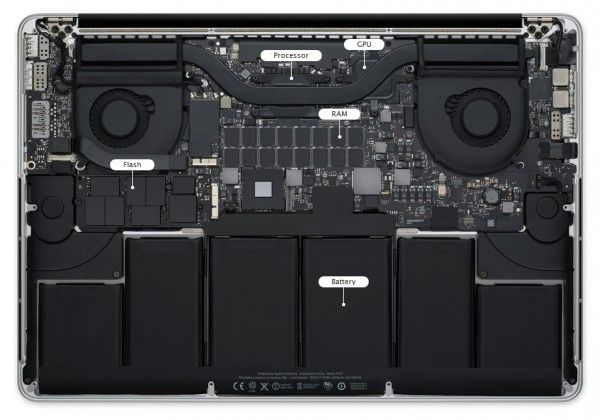 With a huge screen to drive, a power hungry non-ULV platform, and a discrete GPU, you’d think that the MacBook Pro with retina display would get terrible battery life; Apple has gone to great lengths to prevent this — the inside of the unit is packed full of a 95 watt-hour battery — and has managed to deliver 7 hours of web use. Expect lengthy charge times.
With a huge screen to drive, a power hungry non-ULV platform, and a discrete GPU, you’d think that the MacBook Pro with retina display would get terrible battery life; Apple has gone to great lengths to prevent this — the inside of the unit is packed full of a 95 watt-hour battery — and has managed to deliver 7 hours of web use. Expect lengthy charge times.
Apple did something interesting with the fans. To reduce noise they placed the fan blades asymmetrically which they claim spreads the noise over a range of frequencies, instead of stacking them at a single frequency, making the fans sound quieter an less obtrusive.
For the first time ever, Apple is including a full HDMI port on this unit (finally), along with a solid array of ports: 2xUSB 3.0, 2x Thunderbolt, full SDXC slot, and the MagSafe adapter (which has been redesigned to be thinner).
The OS has been updated to support the retina display. A few key apps will already be ready to support the new display such as Adobe Photoshop, Aperture, Final Cut Pro 10, AutoCAD, and even Blizzard’s Diablo 3.
The MacBook Pro with retina display is equipped with dual microphones which ought to work well with the dictation function which is coming with OSX Mountain Lion due to be release later this summer. Apple also says that the stereo speakers in this unit are the best they’ve ever equipped a laptop with. The keyboard is backlit as well.
Apple also interestingly touted a new function called Power Nap which allows the Macbook Pro with retina display to update itself from standby. For anyone following Ultrabook’s, you’ll notice that this sounds suspiciously familiar to Intel’s Smart Connect functionality. It’s likely that Ivy Bridge is what’s allowing Apple to accomplish this (just like an Ultrabook proper), and it doesn’t appear as though we’ll see Power Nap until OSX Mountain Lion.
Apple’s calling the Macbook Pro with retina display “the very best computer we’ve ever built”, and I think they can say that with a straight face.
Price and Release Date
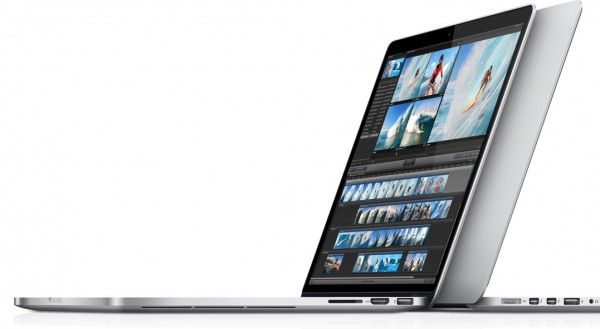 Of course, all of this is going to cost you a pretty penny. The ‘low-end’ version (if you can call it that!) of the Macbook Pro with retina display starts at $2199 and can be configured up to $2399 by doubling the RAM from 8GB to 16GB. The top-end Macbook Pro with retina display starts at $2799 and can go as high as $3749 if by bumping up the CPU from 2.6GHz to 2.7GHz, the RAM from 8GB to 16GB, and the SSD from 512GB to 768GB.
Of course, all of this is going to cost you a pretty penny. The ‘low-end’ version (if you can call it that!) of the Macbook Pro with retina display starts at $2199 and can be configured up to $2399 by doubling the RAM from 8GB to 16GB. The top-end Macbook Pro with retina display starts at $2799 and can go as high as $3749 if by bumping up the CPU from 2.6GHz to 2.7GHz, the RAM from 8GB to 16GB, and the SSD from 512GB to 768GB.
The Macbook Pro with retina display’s release date is today! You can go online and order one now. The low-end model is currently listed as shipping in 5-7 days; same for the high-end model, unless you equip it with the 768GB SSD option, then you’ll find yourself waiting 3-5 weeks.

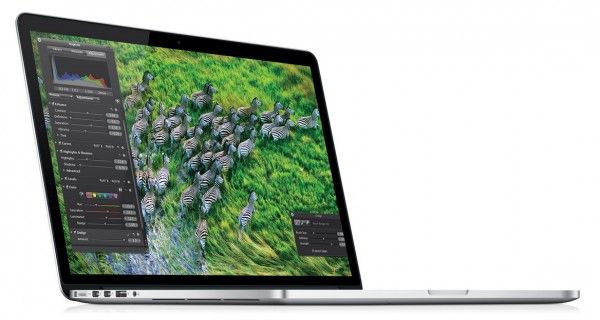


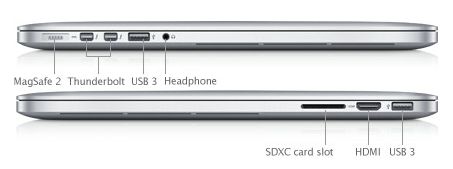










Perhaps now manufacturers can be persuaded into using acceptable displays instead of gluing garbage they find in the bottom of a dumpster outside the pub to their laptops. Yes, I am bitter.
The only problem is that contrary to Mac OS Windows simply does not support high resolution font wise. While you get beautiful properly sized text in MOS the same letters get absurdly tiny in Windows. Scaling up fonts manually distorts the overall look of Windows so it doesn’t solve the problem. Unless Windows introduces predefined font sizes and interface scaling for higher resolution I see no point in putting hd screens in 13″ ultrabooks. At least not for office work and web use.
Resolution won’t be much of a problem for windows 8. Legacy apps though are all over the place and unless they still have developers support to update them then many old apps won’t scale well.
Mind that even for Apple, not all apps will look good on these new screens and it will take them awhile to adjust those apps just like it took time to adjust the iOS apps when they first introduced retina displays.
Though the other problems with higher resolution screens is that it increases the graphical and a bit of the CPU load on systems to properly support those screens, as well as increasing cost and power consumption.
Maybe not at 2880×1800, but 1920×1200 on 11.6″ won’t go amiss.
To be honest 1600×900 is more then enough for 13″. 1920×1080 is almost useless…
I bet this is going to have heating issues like the rest of the MBPs. Thermal throttling galore.
I’d be surprised if Apple slapped all of this heavy hitting hardware in their without a good cooling system. Do the MBPs really have major issues with heat and throttling?
My MBP definitely does. Although I do run software that maxes out the CPUs. It’s definitely noticeable when the CPUs get thermally throttled both in Mac OS and Windows (dual boot).
Too bad the Thinkpads and Latitudes my coworkers use to run the same software never get throttled back.
I’m sure, most consumers won’t notice until maybe they try to watch some Flash videos where even when not being throttled Adobe’s player stutters like crazy.
I have to agree 100% with VJ; especially with 95 Wh worth of battery in there and all that hardware in such a thin case; if you drain this thing when you start charging it it’s going to ROAST.
This is just brute force engineering; put the biggest baddest of everything in a laptop and when the power efficiency drops off of a cliff just shove twice the normal battery capacity into the case. These things are energy bombs waiting to go off. The cost has escalated into the stratosphere, too. Am I crazy or did the market for a Macbook Pro just shrink? (We’ll embrace them happily in the Ultrabook camp.)
I guess it’s the “Pro” line so I shouldn’t expect power efficiency to be a big focus but 95 watt hours to get 7 hours of web surfing? JEEZE!
Adam
Yes, the MBPs have bad thermal designs. I regret choosing a MBP last year when it came time to upgrade my work notebook. My simulations took longer to finish when compared to my previous and slower Thinkpad. Hoping that it was because the Mac OS version of the software I was using was just not optimised well, I tried running them in Windows using Boot Camp. Same thing.
After using some core temperature and frequency monitoring tools, I found out that within minutes the core temperatures hit the Tjunction limit and the CPUs started throttling.
If you have any prolonged CPU intensive workloads, I would definitely recommend to not get a MBP.
Agreed, I feel the same way about the new iPad. Apple made huge engineering trade-off’s in order for a higher resolution screen. Their entire approach feels kludgey & not nearly as elegant as I would have expected from their products.
Since PC manufactures don’t gouge their customers in the same way they won’t make the jump to higher resolutions until the proper tech is actually available. It’s not like PC manufacture are far off either, with the new Asus 11.6″ 1080p at 190ppi versus the MBP at 220ppi.
Also what surprised me was the inclusion of USB 3. This is basically an admittance that Thunderbolt has failed. I remember when Apple said the future of computing was a “single port” design for all I/O. Gone are the days Apple could make a port become an industry standard like they did with the original USB. Firewire, DisplayPort, Thunderbolt have all become enormous failures. Why doesn’t the mainstream tech blogs ever report this stuff?
For my last scheduled hardware replacement, I opted for a Dell Precision to replace my thermally throttling C2D MBP. I was hoping that by Sandy Bridge Apple would have figured out a better heat dissipation design other than throttling. I’m up for another replacement and I guess I’ll be telling the IT department that I’d like another Precision since I doubt Ivy Bridge would help much in this year’s models.
You’d think something that has “Pro” in its name, would actually be useful for professionals. There are professionals out there that actually max out the CPU for more than 10 minutes.
It’s not really “retina”, Apple just arbitrarily changes the viewing distance from the iPhone to iPad to MacBook in order to meet their marketing terms. You would have to be pretty far away to not see pixels at only 220ppi.
Funny how the general tech media never calls them out on it, of course then they probably wouldn’t get review units & no page hits (Apple plays dirty)..
They still tapered the bottom for the illusion of thinness, it’s basically just a MBA without the wedge. Check the pics…
http://www.theverge.com/2012/6/11/3079157/new-macbook-pro-with-retina-display-vs-macbook-air
If there was a 13″ I might consider it, but 15″ is a HUGE let down. The changes to iOS are also just as stale as ever. Ever since the last blockbusters of the MBA & original iPad, Apple seems to have lost it’s magic & this MBP refresh isn’t going to do anything to bring it back. In comparison to Windows 8, Apple is just simply out of fresh idea’s.
Dimensions?
As awesome as it is – the only thing that I really want from this laptop it is the screen. I’m a bit bummed out that they didn’t do more with the Air – the screen to be precise, but I’m convinced that it’s coming in the next iteration.
@Ultrabook News:
I thought this is an Ultrabook Blog? The main competitor for the Ultrabooks is the MacBook Air. So why don’t you mention the IvyBridge Update?
In all honesty the “new” MacBook Air came with nothing new. Sure USB 3.0 and Ivy Bridge, but nothing that really matters got an update.
RacerX, given the weight and size of the MacBook Pro with retina display, it’s squarely in the Ultrabook competitor field! That said, we wanted to get this news up first because it was more newsworthy than the simple refresh that the MBA received, but we’ll get around to that news too.
2399 bucks hehehe
i think the new macbook air fails in the area of weight with devices like the 15 inch samsung series 9 being just under 1.6 kg i dont feel tempted to look at something around the 2 kg range .. granted 14 inch used to be 2 kg but the ultrabook is changes all this.
fraid i couldn’t stop myself – ordered one as soon as store came up been waiting for a hi-res portable, never thought i’d buy a mac but hey, i can use all that screen estate and the ram..
if i don’t like it i can sell it on with mac’s resell values !
Are you using an MBP with Core 2 or later model with Core-i series?
Hahaha, who would buy this?
many many many guys :D
People more concerned with the “look at me factor” and fail to understand that no one cares what notebook you use at you favorite cafe.
Are you serious? The only “competitor” is probably the ultrabook from gigabyte, which sucks compared to this. I frankly hate apple and always have, but they’ve made an incredible laptop here that I’m seriously considering of buying.
$2200-$3500… with no user-accessible or replaceable parts. RAM, SSD, battery, nada. A potential doorstop waiting to happen. That’s a rather expensive paperweight.
Do not want.
Who ever upgrades laptops anyway???
Seriously? I do all the time, as do many who deploy laptops in a business envieonment.
Hahaha, are you serious?